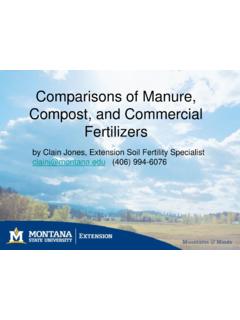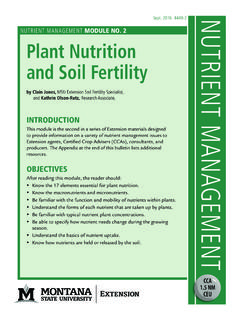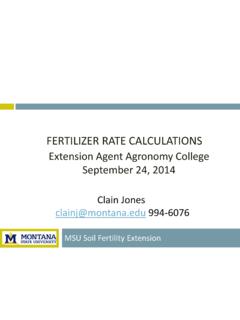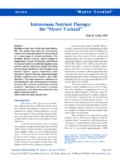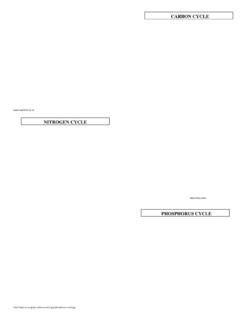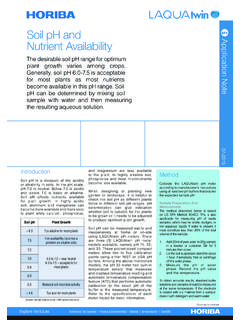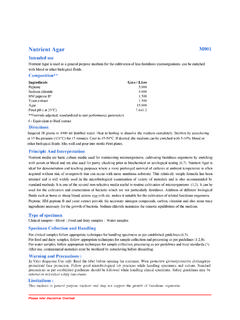Transcription of CCA 1.5 NM Plant Nutrient Functions and …
1 Nutrient Management 9. a self-study course from the MSU Extension Service Continuing Education Series Nutrient Management Module No. 9. CCA. NM. Plant Nutrient CEU. Functions and deficiency and Toxicity Symptoms by Ann McCauley, Soil Scientist;. Clain Jones, Extension Soil Fertility Specialist; and Jeff Jacobsen, College of Agriculture Dean Introduction This module is the ninth in a series of extension materials designed to provide extension agents, Certified Crop Advisers (CCAs), consultants and producers with pertinent information on Nutrient management issues. To make the learning active', and to provide credits to CCAs, a quiz accompanies this module.
2 In addition, realizing that there are many other good information sources including previously developed extension materials, books, web sites and professionals in the field, we have provided a list of additional resources for those wanting more in-depth information about Plant Nutrient Functions and deficiency and toxicity symptoms. Objectives After reading this module, the reader should be able to: 1. Identify and diagnose common Plant Nutrient deficiency and toxicity symptoms 2. Know potential limitations of visual diagnosis 3. Understand how to use a key for identifying deficiency symptoms 4. Distinguish between mobile and immobile Nutrient deficiencies 4449-9.
3 Reprinted June 2011. Background As discussed in Nutrient Management Module 2, Plant Nutrition and Soil Fertility (NM 2), plants require essential Q&A #1. nutrients for normal functioning and How is Plant analysis used growth. A Plant 's sufficiency range is the range of Nutrient amount necessary to as a diagnostic tool? meet the Plant 's nutritional needs and Plant analysis consists of testing maximize growth (Figure 1). The width Nutrient concentrations in specific of this range depends on individual Plant Plant parts during specific growth species and the particular Nutrient . stages (Jacobsen and Jasper, 1991). If Nutrient levels outside of a Plant 's Nutrient concentrations in a sample sufficiency range cause overall crop growth are below or above an established and health to decline due to either a sufficiency range, then the Plant is deficiency or toxicity.
4 Nutrient deficiency deficient or in excess for that element. occurs when an essential Nutrient is not Plant analyses can be performed available in sufficient quantity to meet relatively quickly in the field using the requirements of a growing Plant . semi-quantitative test kits or more Toxicity occurs when a Nutrient is in extensively in a laboratory (Havlin et excess of Plant needs and decreases Plant al., 1999). As a diagnostic tool, Plant growth or quality. Common Nutrient analysis improves the chances of deficiencies in Montana and Wyoming making a correct diagnosis and can be are nitrogen (N) and phosphorus (P), particularly useful in identifying hidden with some deficiencies of potassium (K), hunger or pseudo deficiencies.
5 Sulfur (S), boron (B), chloride (Cl), copper (Cu), iron (Fe), manganese (Mn) and zinc and most likely occurs as a result of over- (Zn). Micronutrient deficiencies are fairly application of fertilizer or manure. uncommon with deficiencies of B, Cl, Fe The three basic tools for diagnosing and Zn occurring most often ( Nutrient Nutrient deficiencies and toxicities are Management Module 7, Micronutrients: 1) soil testing, 2) Plant analysis and 3). Cycling, Testing, and Fertilizer visual observations in the field. Both soil Recommendations; NM 7). Nutrient testing ( Nutrient Management Module 1, toxicity is less common than deficiency Soil Sampling and Laboratory Selection).
6 And Plant analysis (Q & A #1 and #2) are deficiency range Sufficiency range Toxicity range quantitative tests that compare soil or Plant concentrations to the sufficiency range for a particular crop. Visual observation, on the other hand, is a qualitative assessment and is based on symptoms such as stunted Plant Growth and Health growth or a yellowing of leaves occurring as a result of Nutrient stress. This module focuses on visual Nutrient deficiency and toxicity symptoms observed in common crops grown in Montana and Wyoming. Visual Symptoms as a Amount of Available Nutrient Diagnostic Tool Figure 1. Relationship between Plant growth and Interpreting visual Nutrient deficiency health and amount of Nutrient available.
7 (Brady and and toxicity symptoms in plants can be difficult and Plant analysis or soil testing Weil, 1999). 2 Module 9 Plant Nutrient Functions and deficiency and Toxicity Symptoms is necessary to confirm Nutrient stress. and corrective actions may or may not be Precautions in identifying Nutrient stress effective. Therefore, regular soil or Plant symptoms include the following: testing is recommended for the prevention 1. Many symptoms appear similar. For and early diagnosis of Nutrient stress. instance, N and S deficiency symptoms If visual symptoms are observed, can be very alike, depending upon Plant record which crop(s) are affected, their growth stage and severity of deficiencies.
8 Location with respect to topography, 2. Multiple deficiencies and/or toxicities aspect, and soil conditions, a detailed description of symptoms and time of can occur at the same time. More than season that the symptoms first appeared. one deficiency or toxicity can produce Affected field locations can be marked and symptoms, or possibly an abundance of monitored over time using either flagging one Nutrient can induce the deficiency or GPS readings. This information will of another ( excessive P causing Zn be useful in preventing Nutrient stress in deficiency ). subsequent years. 3. Crop species, and even some cultivars of the same species, differ in their Q&A 2 #.
9 Ability to adapt to Nutrient deficiencies and toxicities. For example, corn is typically more sensitive to a Zn deficiency than barley and will show Zn deficiency more clearly (NM 7). I suspect a Nutrient deficiency . How do I. 4. Pseudo (false) deficiency symptoms collect a Plant sample for submission to (visual symptoms appearing similar an analytical laboratory? to Nutrient deficiency symptoms). Potential factors causing pseudo If you suspect Nutrient stress, sample when symptoms deficiency include, but are not limited first appear. To ensure quality results, multiple samples to, disease, drought, excess water, should be collected from comparable locations (similar genetic abnormalities, herbicide and topography, aspect and soil type) and at the same time pesticide residues, insects, and soil of day.
10 Is important to collect the part of the Plant that compaction. will give the best indication of the Nutrient status of the whole Plant . The youngest mature leaf is typically used, 5. Hidden hunger. plants may be Nutrient however, appropriate Plant parts to test will vary with deficient without showing visual clues. crop type and growth stage (see Appendix for additional 6. Field symptoms appear different than resources). Collect numerous (20-30) subsamples of parts ideal' symptoms. Many of the plants from plants that appear both abnormal and healthy, if shown in this module as photographs possible. Subsamples may be combined for one sample. were grown under controlled Nutrient To gather Plant samples, use a clean plastic or paper conditions, and deficiency /toxicity container (metal containers can contaminate samples).
